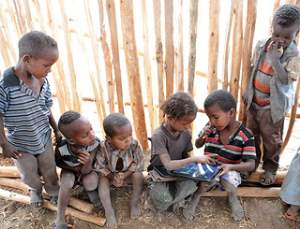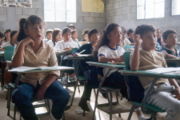Education
|
Ignorance is a contributing factor in many of the problems we face today, such as AIDS, pollution and food production. A first-rate education for the citizenry synergizes
 with every other element of an advanced civilization: scientific discovery happens faster, open collaborative projects grow faster and at a better quality, public health improves, solutions to our problems come faster and ambitious projects like colonising space or curing cancer become more and more feasible. with every other element of an advanced civilization: scientific discovery happens faster, open collaborative projects grow faster and at a better quality, public health improves, solutions to our problems come faster and ambitious projects like colonising space or curing cancer become more and more feasible.
There is no reason whatsoever for education to be a scarce resource. Education is a resource of information, rather than of physical goods, and reproducing information is free. In a world of universal connectivity, education can be ubiquitous if it is made freely available online. This is a task for open collaboration. It is no secret that the schooling system nowadays is in a crisis. Our schools are based on a factory-line model: a child goes in one end, is processed according to a standard procedure and comes out the other end with a certificate. No regard is paid to the person's interests, curiosity, creativity, passion. Students are taught outdated material from a peculiar selection of often irrelevant or downright boring subjects. Their flexibility and capacity to deal with unexpected, non-obvious solutions are not encouraged, and are often actively suppressed. They are not free to pursue their passions and talents. They are not given the chance to apply their skills in any practical way. And worst of all, most students simply hate school. (One study [1] found that only 10-33% of students report being satisfied with school. The same study found that most students feel their teachers are uninterested in supporting them.) How can we promote better education? The answer seems simple: make learning truly interesting, more relevant to the individual and make proper use of modern media. An inflexible curriculum only benefits the schools and assessment bodies. It is becoming ever easier to create interactive 3-D environments such as those found in advanced computer games. With the right scripting for interaction and behaviour, these can make a captivating experience where the student hardly realises they are learning. It is a crime for education not to be interesting! Luckily, for every module of every subject there are educators (and others) who are truly gifted at explaining and teaching key concepts. We must make better use of these people in conjunction with open collaboration and the latest technology to disseminate knowledge to all who wish to learn, wherever they might be in the world.
Some rare people have an exceptional talent at explaining difficult concepts clearly and interestingly. Masters of verbal explanation include Alan Watts, Carl Sagan Alan Kay, the founder of the Viewpoints research Institute, in his TED talk gave some remarkable examples of the power of good explanations, including a method of teaching differentiation to six-year-olds. For the first time in human history, we have the means to pull all of these educational materials together in one place, covering every level of education and every subject, and make it freely available to the world's youth. That means is open collaboration. It is a matter of finding the best teachers in the world and encouraging them to contribute to the common educational resources for humanity (like those linked to above). It may be necessary at first to incentivize contributions from these people, and it is vital to publicize open-source education as much as possible, to generate the greatest possible collaboration. Occasionally particularly talented teachers spring up such as Sudhir Karandikar who got 91 of 104 high-school students to pass a college-level course. Wouldn't it make sense to videotape these people and make their lessons available to the world? Academicearth.org is making an organized effort to find great educators and film their lessons, but there is another, complimentary approach — to allow online communities to upload lessons and allow the best teachers to organically rise to the top. As with all open collaborations, plenty of bad material is submitted (have a look around Connexions for examples). But with the help of ratings, recommendations and dynamic testing, the cream will soon rise to the top. One exciting possibility of a large-scale online learning system is dynamically testing different lessons so that the most effective can be found. Imagine three different videos have been created explaining how molecules come together in a chemical reaction. If these are put into an open-source learning hub, they can each be shown to thousands of users. After seeing one of the three videos, each user is tested on their understanding of the chemical equation. From the results of these tests, the software will be able to know which of the three videos is most effective at explaining the chemical reaction. Anki is an open-source software program that has used this method to calculate the optimal time intervals for repeating facts in order to facilitate memorization. It is even possible in to program software to dynamically model the student's mastery of the material and adjust the difficulty level accordingly. This ensures that the difficulty is always at a level that challenges the student to the full of their ability without being either so easy as to bore them, nor so difficult as to baffle them. Such dynamic difficulty balancing Teachers if they wish could then use any of this material where appropriate, and use their own skills to check it has been understood by their students and elaborate further where necessary. The current education system necessitates the same thing to be explained again and again by millions of teachers around the world - a massive reduplication of effort. It would be a better use of teachers' time to have just a few top-quality explanations of each idea available on-demand, so that teachers can spend time giving students personalized attention. With open collaboration, we have the opportunity to create a global educational curriculum for all levels of education and all disciplines, built from nothing but the most engaging, most colorful, most entertaining and effective explanations, as determined by statistical data gathered from thousands of samples. Educational material can be created and edited collaboratively, constantly evolving and increasing in both quantity and quality, similar to the evolution of the famous wikipedia Such material is made available free for anyone — teachers or students — to use and customise for their own purposes. This project is in early days, but is very much under way already. Listed below are several sites
Stanford University are running an experimental new course from October-December 2011. It is an introductory college course in artificial intelligence, led by Peter Norvig and Sebastian Thrun (a leading developer of self-driving cars). The course is available to all free of charge and combines video lectures with online quizzes and assessments. As of August 2011, over 130,000 people have signed up. In the coming years, courses like this are sure become become more interactive and multiply to cover a greater range of subjects.
The model of education in 20th century school systems involves one teacher, who is supposed to have all the knowledge in his or her head, imparting knowledge to thirty or so students, who are more or less passive receptacles of the teacher's knowledge. One obvious disadvantage of the teacher-and-class situation is that there are thirty catchers and only one pitcher. Just as no one could be expected to play thirty different musical instruments at the same time, no one can tailor their communication to thirty different listeners at the same time. So in the classroom thirty heterogenous nervous systems are exposed to one homogenous stimulus, all at the same rate. Of course, the chance that all the students will understand the material at exactly the same rate and in exactly the same way is zero. Inevitably, some fall behind and get frustrated, others race ahead and get bored, and it doesn't matter how good the teacher's intentions are; nothing can be done within the classroom model to accommodate these students. Flexibility, customization, each student learning at a pace that is correct for him or her — these things simply are not possible in the classroom model. But they are possible in a situation where each student explores educational materials for her- or himself. This is the essence of the Montessori Method Conventional education underestimates the power of a child's playful curiosity about the world. A child is the most sophisticated learning machine in the known universe. Put a child in a room with nothing but a piano, come back three months later, and you would expect that the child will be able to play the piano. An experiment called The Hole In The Wall project has been done in which computer-booths were left in some of the poorest areas in India. There were no teachers or other intervention, just a computer put in contact with children. The findings give strong support for self-directed learning; the children's academic performance consistently doubled or quadrupled, the children learned 200 words of English vocabulary in three months and they became computer-literate within days. Sugata Mitra's TED talk gives more detail. As with the Montessori method, there is no teacher, but children learn by themselves and teach each other in groups. Sugata Mitra is currently researching whether the method can be extended to cover an entire educational curriculum. His research aims to answer the question of whether groups of children can complete their schooling on their own, without a teacher.  In late 2012, One Laptop Per Child revealed perhaps the most powerful evidence to date of student-directed learning. They left 40 Android tablets, in sealed boxes, for children in villages in rural Ethiopia. The tablets were equipped with educational software but the children received no instructions in using them. Within 4 days, the children has taught themselves to use an average of 47 apps each. Within 2 months they were singing the English alphabet and within 5 months they had hacked the software. With cheaper computer technology and the sort of optimized teaching materials described above, this is likely to become the preferred method for education in poor countries. It could be applied to students of all ages. Some skills -- such as walking, riding a bicycle, putting a basketball in the hoop, and swimming -- are most rapidly learned by actually doing it, perhaps with someone who already knows how to do it putting your hands in the right place, etc. Other skills -- such as skyscraper design, aircraft engine-out recovery, parachuting, leading troops into battle, urban planning, etc. -- are generally considered not appropriate for beginners. These skills are today generally learned with a bunch of classroom lectures and simulation. For example, modern flight simulators have a combination of computer graphics (simulating the view out the front window) and robotics (moving the simulator round to simulate the "feel" of climbing, spiraling, rough landing, etc.). Improvements in computer graphics and robotics can improve education in several ways, including:
See also:
Free and open-source computer-aided design/Virtual environments for scenario modelling.
World Game Those responsible for educating the young must recognize that if a young person leaves school with a command of three languages, maths and science, but is overweight, unhappy and socially inept, then our educational system has grievously failed them. Inherent in the open source attitude is a practicality, a faith in the ability of an ordinary person to take on a task and complete it for themselves. But, as Alan Watts said, "Our educational system, in its entirety, does nothing to give us any kind of material competence. In other words, we don't learn how to cook, how to make clothes, how to build houses, how to make love, or to do any of the absolutely fundamental things of life. The whole education that we get for our children in school is entirely in terms of abstractions. It trains you to be an insurance salesman or a bureaucrat, or some kind of cerebral character." This must be remedied. People must also be taught to think for themselves, rather than learning by rote - again something sadly lacking in most education systems. There is useful scientific knowledge now emerging from positive psychology (and from the scientific study of Buddhist practices etc.) in how to create happiness. This is working its way into the school system, with the UK government recently making a course on Social and Emotional Aspects of Learning (SEAL) a standard feature in British schools. It seems reasonable to expect people to be educated in the fields of practical psychology (both for controlling their own emotions and behaviours and for optimally dealing with other people), engineering (including the use of a Fab Lab), cookery, computer programming, agriculture (growing their own food), exercise and sport science, music, dance, art and social entrepreneurship as well as the intellectual subjects ordinarily taught. The time saved by more efficient teaching of the abstract subjects will more than make room for such an expansion of the curriculum. |
 [print version]
[print version]  [update]
[update]  [site map]
[site map]Detailed tour:  previous page | next page
previous page | next page 

